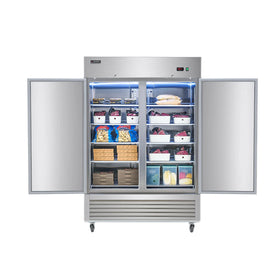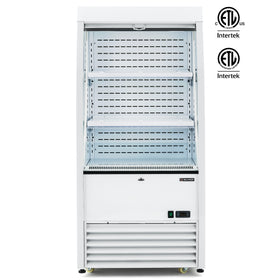Thawing salmon seems rather easy, and almost everybody has a vague idea of how to do it. However, the point of thawing salmon is not just to get rid of the ice blocks and render it “cookworthy”.
- Salmon has to be thawed in a way that preserves its flavour, texture, and, most importantly, the basic rules of food safety.
- If not thawed correctly, your salmon could easily end up dry, mushy fish or, worse, exposed to bacterial contamination.
Whether you’re preparing a single fillet at home or handling large batches in a commercial kitchen, the five methods of thawing salmon we introduce in this blog will ensure your salmon is well preserved, ready for cooking, and safe to eat.

Method #1. Thawing Salmon in the Refrigerator (The Safest Method)
Thawing salmon in the refrigerator is the safest and arguably the most effective method of thawing salmon. Always thaw your salmon in the refrigerator, especially if you are not pressed for time or if you are planning.
Here is a short list of what you need, and a detailed guide on how to thaw your salmon in the refrigerator:
What You Need
- Your frozen salmon (fillet, steak, or portion)
- A plate, shallow dish, or tray
- Plastic wrap, foil, or resealable bag (if salmon isn’t vacuum-sealed)
How to Thaw Your Salmon in the Refrigerator: Step-by-Step Process
i. Check the packaging
If your salmon is vacuum-sealed, let it stay in its packaging. Do not remove it
If the package is loosely wrapped, rewrap the pieces to prevent leaks and odors from spreading.
ii. Prepare Your Tray
Place the salmon on a plate or shallow dish before putting it in the fridge. The role of the tray is to catch any thawing liquid. This prevents contamination of other foods in the fridge.
iii. Position The Salmon in the Fridge
Carefully place the salmon on the bottom shelf of your refrigerator to avoid drips contaminating other items.
Ensure the fridge is at 40°F (4°C) or lower.
iv. Thaw slowly
The key to thawing salmon in the fridge is patience. You cannot do this while in a hurry because it takes a lot of time.
Small fillets (6-8 oz) typically take 12-18 hours to thaw in the fridge
Larger fillets may take 18-24 hours, while whole sides (2-3 lbs) can take up to 36 hours.
v. Check for readiness
When your salmon feels pliable, but still cold enough, it is properly thawed and ready for cooking.
To check for readiness, press gently or flex the fillet to confirm thawing. Avoid any icy spots.
vi. Use promptly
Cook thawed salmon within 1–2 days for optimal freshness and safety.

Method#2. Cold-Water Bath Method (Faster Thawing)
When time is of the essence, a cold water bath is the best way to thaw your salmon. Sometimes, waiting 12–24 hours isn’t practical. The cold-water bath method is a safe, faster alternative.
Here’s what you need and how to do it
What You Need
- Frozen salmon in a sealed plastic bag
- Large bowl or clean sink filled with cold water
How to Thaw Your Salmon in Cold Water: Step-by-Step Process
i. Seal the salmon
Proper sealing prevents water from touching the fish, which could affect its texture. Most people use zip-lock bags to seal the salmon when thawing it with this method.
ii. Submerge in cold water
- Use a bowl or sink large enough to fully cover the salmon.
- Place a small plate on top if needed to keep it submerged.
iii. Change water regularly
Swap out the water every 30 minutes. The objective of changing the water when thawing your salmon is to maintain a safe temperature.
iv. Thaw for the Appropriate Thawing Time
The time it takes to fully thaw salmon by using cold water depends on the size of the fillets
- Small fillets take about 30-45 minutes
- Large fillets or sides can take about 1-2 hours
v. Cook immediately
Salmon thawed in water cannot be stored again in the fridge.

Method#3: Microwave Method
Thawing salmon in the microwave is the fastest method to get it fully thawed, but it is also the riskiest method in the sense that it may end up partially cooking the salmon or producing an uneven texture. It is not wise to thaw your salmon in the microwave except you are in an urgent situation.
In that case, follow these steps:
- Place salmon on a microwave-safe plate.
- Use the Defrost setting (about 30% power).
- Heat in 1-2 minute bursts, flipping and rotating the fillet.
- Stop as soon as the salmon is pliable; the edges might start cooking quickly.
- Make sure the salmon is cooked immediately after thawing in the microwaving
Again, remember that the microwave thawing may partially cook the salmon and produce an uneven texture. Only use in urgent situations.
How to Thaw Salmon: 4 Ways That Work
| Method | Time | Safety | Notes |
| Fridge | 12–36 hrs | Highest | Best flavour and texture; can refrigerate 1–2 days post-thaw |
| Cold Water Bath | 30 min–2 hrs | High | Must cook immediately; very fast and reliable |
| Bowl (small-scale) | 30–45 min | High | Works for fillets, not large sides; cook immediately |
| Microwave | Minutes | Medium | Risk of uneven thaw; must cook immediately |
How to Tell If Salmon is Fully Thawed
To tell if your salmon is fully and properly thawed, you can either use the press test, check for flexibility, or even slice it to the centre if you are still unsure. Here are four ways to verify if your salmon is properly thawed
- Use the press test: Gently press the thickest part of the fillet; it should yield slightly.
- Check flexibility: When salmon is fully thawed, it bends easily without cracking. Hold on to two sides and gently bend to verify.
- Do a surface check: If there is no frost, ice crystals, or hard spots remaining, it is likely properly thawed.
- Do a cut test: If you are still unsure, slice the fillet into the centre. It should be soft and even in colour.
Pro Tip: If the salmon is almost thawed (slightly icy in the centre), cooking will finish the thawing safely.

Tips for Thawing Salmon in a Commercial Refrigerator (Large Quantities)
If you’re handling bulk salmon in a restaurant or processing environment, consider the following tips for thawing your salmon in a commercial refrigerator:
- Consistent low temperature (32-40°F / 0-4°C) to keep fish safe while thawing.
- Spacious interior with adjustable shelves - allows trays to be laid out flat for even thawing.
- Stainless steel surfaces - easy to clean, prevent contamination.
- Forced-air circulation - ensures uniform temperature throughout the fridge.
- Drain pan or tray - collects thawed liquid to prevent messes and cross-contamination.
Tip: Arrange trays in a single layer with space between them to allow proper airflow and faster, even thawing.
Why Your Salmon Must Be Thawed Properly
Salmon is a delicate, high-protein fish, and so you must pay attention when thawing: its texture can quickly degrade if thawed too quickly or unevenly.
Improper thawing can:
- Result in uneven cooking: the frozen centres will remain undercooked while the edges overcook and even burn.
- Ruin its texture: Quick and impatient thawing or excessively warm water can make salmon mushy.
- Increase the risk of bacterial infection: thawing at unsafe temperatures allows bacteria like Listeria or Salmonella to grow.
Again, the goal is to thaw your salmon slowly and safely, keeping it cold yet pliable, ready for cooking.
Conclusion
To thaw your salmon, plan ahead: the fridge method is safest and easiest. Keep it cold: never use warm or hot water, allow air circulation to prevent uneven thawing.
Remember to cook promptly, especially for water- or microwave-thawed salmon. Always check readiness: use the touch test, flexibility, and cut tests to confirm thawing.
By following these methods, your salmon will thaw safely, evenly, and maintain its optimal texture and flavor, whether for a weeknight dinner or a busy commercial kitchen.
Consider this complete guide on how to store butter in the fridge, and many other useful guides from Wilprep.










